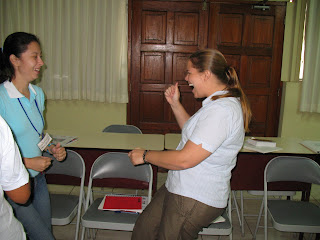More 80's Music References
>> Thursday, January 31, 2008
There's a really great article in Time Magazine about Nicaragua and I suggest everyone check it out. It even mentions Masaya, so it's almost like we were mentioned in Time.
Tuesday, Jan. 08, 2008
'How Far Are You From the Place Bono Sang About?'
By Tim Rogers/Managua
A year after Irish rocker Bono visited Nicaragua in 1986 in an effort to raise awareness about Central American war refugees, U2 released its smash-hit album The Joshua Tree and Nicaraguans immediately recognized that one of the songs was written about their country. Twenty years later, most people here still hold as fact that "Where the Streets Have No Name" was written about Managua, a squat and sprawling capital city where... well, the streets are unnamed.
The Managua of today still has the feeling of a rural backwater that hopes to one day grow up to be a capital city. No building is taller than 10 stories. There are still more trees than buildings, and going "downtown" means going to the Metrocentro shopping mall.
Finding one's way around Nicaragua means developing an intimate understanding of the spatial relations between current and past landmarks, some of which were destroyed more than 30 years ago in the 1972 earthquake. Stephen Kinzer, a former New York Times bureau chief based in Managua in the 1980s, accurately describes the fine art of giving directions in Managua as a "Socratic" technique, based on first determining what the direction-asker knows, then working backward from there.
For example, if a foreigner were to ask, "how do you get to the Nicaraguan Tourism Institute?," the conversation might go something like this:
"Well, do you know where Casa de Los Mejia Godoy is? Where Antojitos Restaurant used to be?"
"No."
"Do you know where the former Lips strip club was?"
"No."
"The Hotel Crowne Plaza, which used to be the Hotel Inter-Continental?"
"Bingo."
"From there, it's one block south, one block down."
One block "down," of course, is Managua code for "one block west." And, in the case of the Tourism Institute, west is literally downhill, so you can't get lost. In other cases, however, "one block down" really means one block uphill, adding a new level of adventure to the game. To further confuse things, directions are also given in an anachronistic unit of measurement known as a "vara," which is apparently based on the arm-length of a former nobleman from sometime and someplace in the distant past.
Outside of the capital, giving directions is an equally colorful experience. My girlfriend's college friend lives in Jinotepe, "half a block north from where the Indian died." Even on the Caribbean coast, which was settled by the British rather than the Spaniards, things are equally relative. British expatriate Louise Calder lives in the Caribbean city of Bluefields, "in front of Francisco Herrera's house." Her neighbor, Mr. Herrera, in return, lists his address as "in front of Louise Calder's house."
My favorite address story, however, comes from neighboring Costa Rica, where I lived for several years before moving to Nicaragua. Six years ago, my friend Blake Tenore sent out an e-mail to a list of old college friends, asking for people's addresses to send out Christmas cards. Since I lived in a house without a street address, I jokingly e-mailed him back with the directions that I used in Spanish to tell people how to get to my house: "From the Lourdes Church in Montes de Oca, two blocks west, past the Pali supermarket, take a right at the next corner where an old woman sells fruit, past the Bar Maguey and go to the end of the dead end street, where there's a two-story white house with a black gate, where the gringos live. Costa Rica, Central America." To my surprise, a Christmas card arrived three weeks later, with the smallest and most careful handwriting I have ever seen printed on an envelope.
The funniest part about giving directions in this corner of the world is that some streets actually do have names, but no one knows what they are. My girlfriend, by chance, recently saw an official government map of her hometown, Masaya, Nicaragua, and discovered that the street where she had grown up in fact has a name: Calle Palo Blanco.
Now, as a joke, sometimes when we get into a taxi, we tell the cab driver to take us to "Calle Palo Blanco," to which he invariably responds by staring at us blankly in the rearview mirror. Then we give the more common address, "From the San Jeronimo Shell Station, two and a half blocks down." And off we go without further question.
So perhaps Bono did in fact write a song inspired by his trip to Nicaragua, but my guess is that it was "I Still Haven't Found What I'm Looking For."















